Meet the new generations charged with maintaining and enriching their religious identity in a multicultural island nation
By Savita Tiwari, Mauritius
On the dark evening of November 2nd, 1834, thirty-six Indian laborers arrived at Port Louis, Mauritius, on the Atlas, the first ship to bring Indian indentured laborers to Mauritius. Apprehensive at the unknown lives that awaited them, they disembarked onto Mauritian soil, perhaps unknowingly embedding the footprint of Hinduism onto this foreign land. Together, they would create a cultural and religious impression that would last into the foreseeable future.

Each of these immigrants carried his or her bundle of personal possessions from the homeland: Indian clothing, scarce personal trinkets, and copies of the Ramayana—the classic story which would serve as a foundation and anchor for Hinduism in this new country. These books, some given as departing gifts from their family and elders, carried the message that even though you are leaving everything you know behind, you must never abandon your dharma.
Mauritius was named in 1598 by the Dutch after their Prince Maurice of Nassau. However, the Hindu folk tales by our Mauritian forebears have another version of the story. They call it Marich Desh, after the demon king Marich. It is said that Marich and Subahu were brothers, the sons of the demoness Tadaka. Marich was Ravana’s maternal uncle, as Tadaka was the mother of both Marich and Kaikasi. We all know the story where Ram killed demoness Tadaka and her son Subahu, but mistakenly shot a crooked arrow towards Marich. The arrow struck Marich’s chest and threw him a hundred miles away, into the ocean.

In the Ramayana that story ends there; but in Mauritius it continues in the form of a folk tale. It says that Ram’s arrow threw Marich to the island of Mauritius. Marich’s life was spared, and he became a saintly person. He lived the life of an ascetic on this island, setting up an ashram and renouncing his demonic qualities. He began to realize his past mistakes and became a devotee of Ram. When Ravana approached Marich to help him with the abduction of Sita, Marich refused. Ravana threatened him with death, but Marich chose instead to die by the hand of Ram. When Ram killed Marich in the form of a golden deer, Marich accepted his sins, and Ram gave him a boon: his island would henceforth be called Marich Desh, Indians would one day come to the island with the Ramayana, and Ram’s name would echo throughout the country. Thus, Marich died peacefully.
Our ancestors found solace in this story and considered that they were brought to this foreign land by the will of Ram. The indentured immigrants lived challenging lives under English rule. Toiling all day in sugarcane fields, at night they took shelter in Ram’s name and chanted the Ramayana’s verses in groups, forgetting their pains of the day and the problems of tomorrow. That’s how Hinduism survived those arduous old days in Mauritius. Today, 187 years later, Hinduism is as heartfelt as when it arrived on the island. The newer generation is bringing forward the teachings and rituals of Hinduism in their own way.
An Evolving Heritage
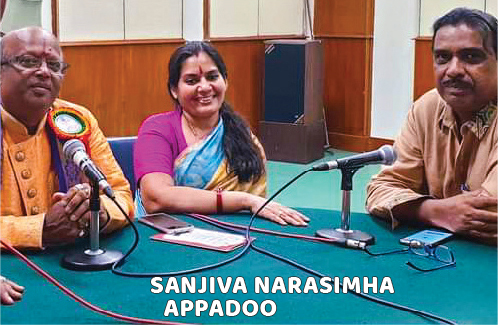
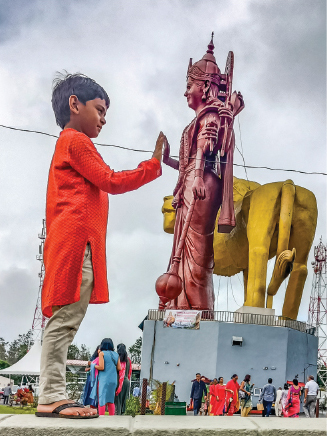
For this article I have talked to many Hindu youth. One thing is clear: the present generation of Mauritians are vastly different Hindus from their elders. While the elder generation largely thought of themselves as Indian Hindus, this generation identifies themselves as Mauritian Hindus. This fifth generation has accepted that, being born here, they are not Indian but Mauritian and that their way of practicing their religious tradition is distinct from Indian Hindus. Due to an early lack of means and facilities, the practices and traditions evolved in a unique way through those five generations, and today’s youth consider the Mauritian practices as their heritage.
A Complex Culture
Mauritius is well known as a rainbow nation. Its population is 50 percent Hindu, 16 percent Muslim and 24 percent Christian. These groups, each strong in matters of their faith, have lived in relative peace and harmony. French Creole is spoken as a first language by 90 percent of islanders. In addition, substantial numbers speak one of six Indian languages, as their ancestors were brought from widely different parts of India. The majority, sailing from Calcutta, spoke Bhojpuri; Marathi speakers sailed from Mumbai; speakers of Tamil and Telugu sailed from Madras (now Chennai). Hindi- and Gujarati-speaking laborers were also brought to the island. Each of these language groups included various subcultures. Another group, a small number of Indian merchants, would later sail to Mauritius from Surat, in Gujarat.
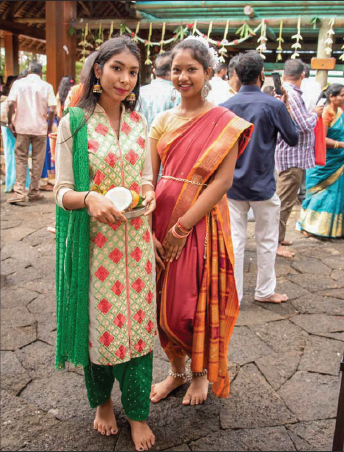
Hindus in Mauritius are classified based on language. Bhojpuri-speaking people whose ancestors came from the state of Bihar in India are simply called “Hindus,” as are small communities like Gujaratis. Others have modifiers: for example, a Marathi speaker is called “Marathi Hindu” or just “Marathi.” The same goes for other ethnic groups of Tamil and Telugu Hindus. Even government forms have the options of Marathi, Tamil, Telugu and Hindu in the religion section.
These distinctions stem from the colonial days, when indentured laborers were brought to Mauritius from different parts of India. Once in Mauritius, each community was split up, employed on different plantations across the island. Few people of any one community were employed together, to prevent the formation of organized groups. Even many husbands and wives who arrived together were separated in this way. All the Indian communities were mixed so that communication was difficult.
The first generation of these indentured laborers lived where the colonial powers forced them to. But the second generation—the first generation of Mauritius-born Hindus—understood the disadvantage of living apart from others of their same language and heritage. When the indenture laws were amended, giving more freedom, they formed their own communities, united by language and culture, the smaller groups calling themselves Tamil, Telugu, Marathi or Gujarati to distinguish themselves from the majority Bhojpuri-speaking Hindus. Mauritian Hindus have long come to accept these classifications in everyday life, while knowing we are all of the same core religion.
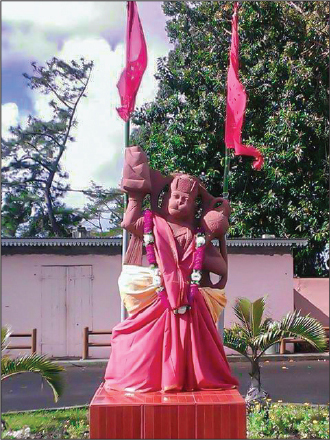
Some customs spread among the various groups. Telegu scholar Sanjiva Narasimha Appadoo explains: “When Indians were brought to Mauritius, they lived together in mixed communities for a long time, so the culture and rituals got intertwined. For example the Bhopuri-speaking Hindus brought the tradition of Hanuman Chautra, a shrine at one’s home where an image of Lord Hanuman and two red flags are placed. The huts were so small that they made a shrine outside their huts. They placed a stone at the entrance of their huts and just like that the tradition of Hanuman Chautra at the entrance of the house started. The other Hindu communities from the south and west of India also adapted these traditions. So today the Hanuman Chautra can be seen in many Tamil, Telugu and Marathi families. Everyone changes the flags yearly by inviting priests for a prayer, and they also invite elders. If someone wants to make it big they organize this flag changing on their child’s birthday.”
Another notable cultural exchange happened in the cuisine. Today, most of our island’s Hindu communities serve seven curry platters during marriages and other auspicious occasions. This tradition came from South Indian communities. Puri, the fried bread from North India, also made a place for itself in this platter as a staple along with rice.
Our Hindu Mauritian ancestors did what they thought was right while so far from their cultural origins. They all knew they were a part of the larger Hindu community, and that they prayed to the same Gods. But to preserve their culture and religion, each group cocooned itself, and each generation instilled in the next the need to protect our traditions and beliefs in this new land, and transfer our religion to the next generation.
The newer generations have found themselves in a larger and more connected world. They are emerging from these cocoons and simply calling themselves Hindus. None of my interviewees mentioned that they were Marathi Hindus, Tamil Hindus or any other. They are simply Hindu.
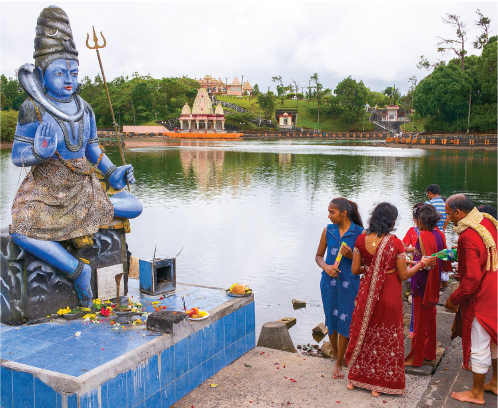
The Caste Factor
The Indian population is further divided into jatis. Most people think Mauritius is a casteless society, due to absence of caste-indicating surnames. The Indian surnames with which immigrants arrived in Mauritius weren’t even noted on the papers. And the spellings of their first names were written in a distorted manner by the English officers. But people kept note of their own jati and family tradition as much as possible. At present caste only comes into the scene at the time of marriage. Though inter-caste marriages are a common phenomenon here, parents do urge their children to marry into their jati or at least their community, like a Tamil marrying a Tamil. Most of the interviewees said that although they do not pay much attention to caste, it does affect their personal or social life in some way.
Hinduism and the Media
Many Mauritians start their day listening to the religious songs played by the state-owned radio station. Radio always plays in the background while people complete their morning household chores. The selection of songs depends on the day: Siva songs are played on Monday and Hanuman songs on Tuesday. Wednesday is reserved for Ganesha, Thursday for the guru, Friday for Lakshmi, Saturday for Venkateswara and Sunday for Surya songs. Every evening a 20-minute session plays a mix of bhajans. Acharyas and pundits are also invited to the studios to deliver discourses.
Every day at 5am, the state TV channel broadcasts the Aastha channel from India, showing Baba Ramdev’s yoga programs. This one-hour show is popular among Mauritian Hindus. These radio and TV programs are an integral part of Mauritian Hindu life.
Hinduism and Politics
As half the population is Hindu, all Mauritian presidents but one and all prime ministers but one have been Hindus. Most Hindu celebrations are public holidays. The candidates in constituencies are selected on the basis of religion and jati. Because of this, some youth feel that government jobs and promotions are another area where their jati matters.
A government-appointed task force makes sure that state-observed holidays, festivals and fairs are organized in a smooth and safe manner. Aside from that, the government doesn’t interfere much with the religious traditions and customs of any religion.
Hindu Life in Mauritius
At the entrance and exit of almost every village in Mauritius is a Kali temple or shrine, a Kali Maiyee. Here Maa Kali is prayed to as Gram Devi, or Village Mother. Seven stones are placed under a tree or at the feet of the Goddess to represent the seven forms of Kali. In some of the older villages these stones were placed centuries ago by our ancestors. The present generation visits Kali Maiyee in notably good or bad times, making the obligatory offering of kheer-puri. You’ll commonly find someone there after the birth of child or after a marriage, or when someone falls severely ill and recovers.
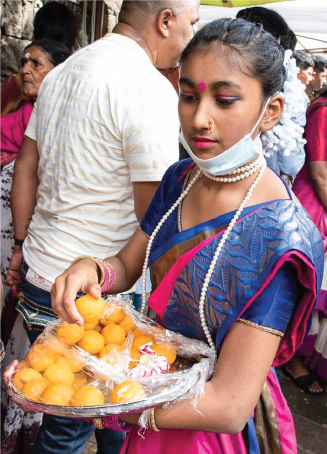
Once a year, a community prayer is organized at these Kali Maiyee where all the residents of the village contribute and participate. In the early days, there was a custom of doing an animal sacrifice, but this has stopped because newer generations feel that such rituals do not belong in Hinduism. Different ethnic groups pray to the Goddess in different ways. The Telugu community prays to Her as Ammoru, meaning “mother of the village.” At some temples there is a yearly tradition of the women walking in a procession from one temple to another carrying water pots above their heads.
Another common practice for Hindus on our island is to visit a brahmin or call him immediately after a child is born. The child’s birth time is registered with the priest, and the first letter of their name is calculated according to the horoscope.
When someone dies, the first call goes to the priest to check if panchak nakshatras are prevailing. Elders believe that if a person dies in this astrological time period, they will take four more people’s lives with them. The youth are skeptical about these customs, but they will go obediently and check with the priest when told by elders to do so.
Almost all interviewees said that Hindu youth can be identified easily by strangers because most wear a red raksha sutra (sacred thread) on their wrist, tied by a priest during a prayer at their home or in the temple.
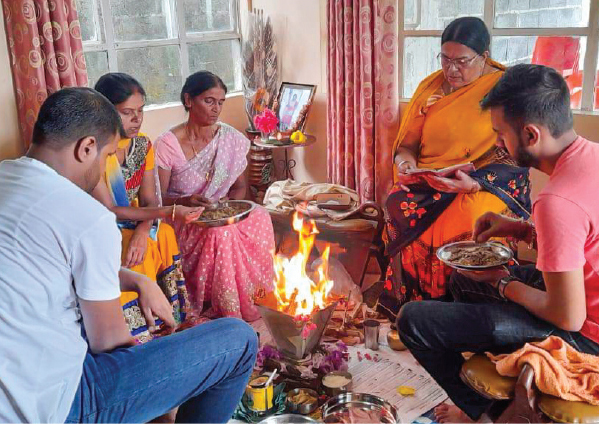
Hindu houses, too, are easily recognized here. Along with the home shrine inside the house, almost all have the aforementioned Hanuman Chautra—a Hanuman shrine adorned with two red flags. One can also see several bottles at the entrance, usually a transparent glass bottle such as a Coke bottle, filled with holy Ganga water from Ganga Talao of Mauritius. It is believed that the Ganga water keeps evil and negativity at bay.
Young Hindus of Mauritius
A few common themes came to light while talking to the interviewees. Everyone seems to enjoy Hindu festivals. Even those who identify themselves as “spiritual but not religious” joyfully participate in these festivals, enjoying getting together with extended family on Rakhi or on colorful Holi. Mauritius provides a whole calendar year full of events. In the Satyanarayan Katha ceremony, performed at home, hundreds of family members and friends gather for the whole day to pray for someone’s successful marriage. At Mahasivaratri, it seems like the whole island makes a pilgrimage to our most sacred lake, Ganga Talao. The young Hindus of Mauritius enjoy it all.
On the other hand, the youth do not like the tantric rituals some people perform. Sometimes they find a lemon with coins and red sindoor, and maybe even a sacrificed animal, outside someone’s home. All the interviewees condemn these acts. They point out that the police don’t seem to act on people’s complaints about such activities.
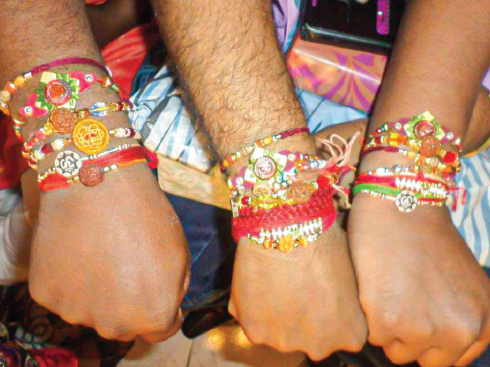
Overall however, interviewees say they enjoy their religious traditions. Social life is very busy, with constant invitations for friends’ and sisters’ weddings, or to Ganesha Chaturthi Deity installations at friends’ homes, to join in the traditional jhakri dance. Then there is the one month of being strict vegetarian during the kawaar construction during Mahasivaratri, when a friend might participate in fire-walking kavadi and is in need of someone to cheer them on.
A young Hindu will be asked by their mother to light a lamp at their Hanuman shrine while dinner is being prepared at sunset. Some youth say they don’t like to do it, but sure enough even when mom is not home, the lamp is still lit on time without anyone asking.
Our youth uphold the chanting of the Ramayana near the deceased until the body is cremated, but many dislike other practices, like covering all glass windows of the house with a bedsheet or other available cloth until the body is taken for cremation. They also condemn the treatment of widows, who are no longer allowed in many auspicious rituals.
So these are the young Hindus of Mauritius—enjoying, exploring, critiquing and transforming Hinduism all at once on this little piece of paradise called Mauritius.
I made a small questionnaire for our interviews in which the foremost question I asked of them is if they identify themselves as Hindu. If yes, the next question was, if a stranger could identify them as Hindu? Do they wear something that announces their religious identity? I also asked about 16 samskaras, and their two favorite festivals. I asked for two because I assumed their first favorite festival would always be our massive celebrations of Mahasivaratri. I also asked what they like and don’t like about Hindu customs in Mauritius, and about their take on caste as it presents itself here. From there I let them speak their mind.
Keshav Porahoo
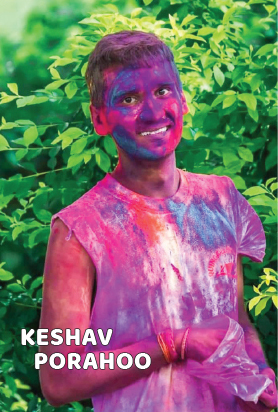
Keshav Porahoo, 24, works as a network specialist at Orange Telecommunication. He comes from a very religious family and self identifies as Hindu, declining to categorize himself any further: “I believe in God and perform the rituals. In short, a believer.” The samskaras he has done are namakarana, annaprasana, chudakarana, karnaveda, vedarambha, etc., and he is waiting for his next samskara, vivaha (marriage). His raksha sutra at the wrist and rudraksha at the neck identify him as Hindu.
His two favorite Hindu festivals are Mahasivaratri and Ganesha Chaturthi. Mahasivaratri for the amazing vibrating Siva bhakti atmosphere at Ganga Talao and all over the island. Ganesha Chaturthi for its high-voltage prayers with drums, other musical instruments and Jhakri dance.
Jati, he said, is sometimes an issue in Mauritius. “During high-profile gatherings, I’ve witnessed the jati system and that the privileged ones get priorities. The politicians give preference in government jobs to people from their own jati. During marriage, also, parents bring up this topic. Other than that, jati does not much affect the common day-to-day life of young Hindus in Mauritius. I love the rituals of Hinduism, but I would like to change the way they are performed to look more appealing than boring. Music should be given more importance, to enhance the atmosphere of bhakti. The one thing I don’t like about the Hindu community in Mauritius is that we are not united. The other religions on the island consider this vital, and they act as one.”
Yadav Muneshar
I have known Yadav for the last 14 years. I have seen him as an obedient child sitting in prayers and as a mischievous teenager exploring spirituality by asking questions about every ritual during prayer, and eventually becoming an ardent Krishna devotee and a project head at their family business, Govinda’s Veg Food.
“Definitely, I am a Hindu,” he said. “A vegetarian Hindu,” he emphasized with a laugh. I asked what’s so funny, and he replied, “I see Hindus all around the world talking about compassion while eating nonvegetarian food. Those things don’t go hand in hand. And that’s the only part I don’t like about Hinduism.”
He continued, “I like pilgrimages. As an explorer, I really enjoy going on spiritual tours. As a Krishna devotee, I go regularly to Mathura and Vrindavan in India. I have also been to Badrinath, Kedarnath and many other places. My father has been to Kailash Manasarovar. Meeting new people in holy cities is an amazing experience.
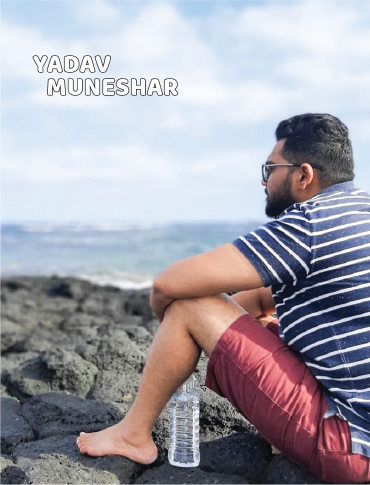
“Hinduism does not affect me directly in the day to day. But yes, I can feel the presence of Hindu identity in the background of my life. For example it is obligatory to do prayer at the home shrine, and my mother performs that duty with all her devotion. I sometimes feel it is too much hard work for her. I hardly participate in everyday prayer due to work, but I go to temple with them occasionally on Sunday evenings. We have darshan, sit in kirtan, meet friends, have prasad as dinner at the temple, and then come back home after participating in the shayan arati, the sleeping bhajan for Krishna. My mother can go to temple every day if time allows. My father visits Mathura-Vrindavan in India every time he goes on a business trip to Malaysia, once every two months. That’s how religious my family is. I enjoy going to temples and participating in prayers. But I have carved a different space for myself.
“Yearly prayer at our house is obligatory, and we invite all family and friends. Mahaprasad, a seven-curry platter is served to everyone. They come to our house and we go to their house for these yearly prayers. So the beauty of Hinduism is we participate together. Sometimes it feels too much, but the presence of friends makes it bearable.
“Of course I have friends outside my religion. Mauritius is a rainbow island with many religions and ethnic groups. Hinduism is flexible, so it is easy for us to mingle. When a friend says Allah is great, I agree that yes Allah is great. When a friend says, Jesus is great, I agree, yes Jesus is great. Hinduism taught me to respect all religions. But it is not the same with them; not everyone agrees that Bhagwan is great. It is also easy for me to ignore them. As Hinduism says, respect the views of others.”
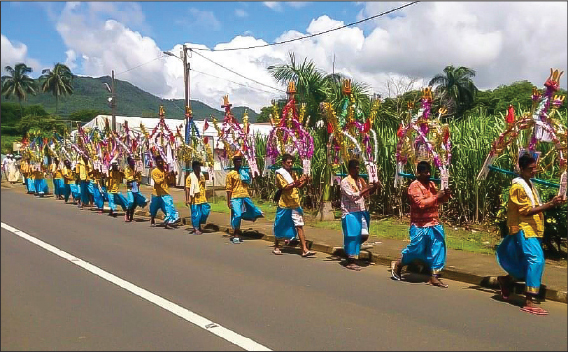
Shyachin Kumar Aucharaj
Shyachin Kumar Aucharaj, a planter by profession, identifies as a Hindu and wears a red thread, raksha sutra, on his wrist so others identify him as Hindu.
“I come from an Arya Samaj family. We don’t believe in idol worship, but it’s common for an Arya Samajist in Mauritius to have Hanuman dhwaja at their house entrance. Arya Samaj only believes in the Vedas and the Vedic fire ceremony (havana), but the reading of Ramayana near a dead body until it is cremated is a tradition I have seen followed in my family as well.”
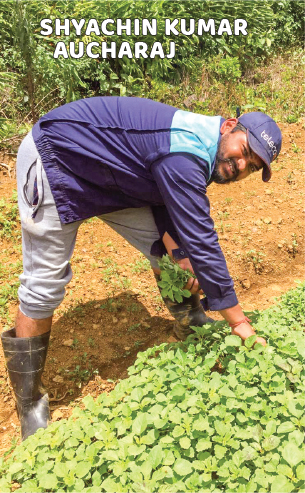
He has performed namakarana, vidyarambha and vivaha samskara. “My family performs weekly and monthly havana at home. We don’t ordinarily go to temple, but on New Year’s, Mahasivaratri, Durga Puja and other festivals we go to the nearest temple with the whole family.”
His favorite festivals are “Mahasivaratri because of the strong bond that connects everyone when they go to Ganga Talao, and second is Diwali, because we go to everyone’s houses to distribute sweets, which is like distributing happiness.”
His favorite regular family custom is the monthly fire ceremony on Purnima, when the whole family sit together for a small fire ceremony. “My father has three brothers and my grandfather had two brothers. Now everyone lives individually but in the same compound, so whenever there is any function we are 60 or so people from the close family itself. You have your privacy, but you are never alone. The monthly fire ceremony brings positive vibes in the house.
“I have nothing to dislike in my family Hindu custom, as we are free to skip the program if anything important comes. I love our culture, and the only thing I want to change in Hindu society is the superstitious mindset of people toward religion.” Schyachin is also firm believer in Sai Baba. His motto is sabka malik ek hai—God is One. “We live on a small island with many communities. So it’s important to respect all religions. As a planter, I also pray to Bhudevi, Mother Earth, when I reach my fields early in the morning.”
Nitin Gookul
I decided to interview Nitin even though he is a couple of years over the age range of 18 to 28 which was set by my editor. I met him briefly last year when he launched his first book, The Spiritual Science of Vedas, which is written with a deep understanding of the subject.
“I am from a moderately religious family. We celebrate all the common festivals that are celebrated in Mauritius, like Durga Puja, Mahasivaratri, Hanuman Jayanti, etc. I self-identify as a Hindu, as I have done namakarana and annaprasana. We regularly have Vedic yajnas at home and Satya Narayan katha. We observe all religious festivals like Hindus.
“I won’t call myself religious. I think I have already completed that phase of being religious in my life and now I have reached a stage where I call myself spiritual. By spiritual, I mean you have a real understanding of your religion and now you are on your path to transcendent understanding. People can easily identify me as a Hindu. I wear Tulsi-mala neck beads, Narsimha Kavach, Rudraksh and red Raksha Sutra. Sometimes Vaishnava Tilak when going to Vishnu temple.”

I pointed out that it’s unusual to see young people with so many religious identities. “Yes, it’s unusual for a Mauritian youth, but I don’t wear them out of fashion or obligation. I wear them because they align with my energy.”
Asked to categorize himself within Hinduism, he replies, “Spiritual, but believe in rituals, too, especially Vedic yajnas. Favorite Hindu festival is Deepavali, because I enjoy sharing sweets with the community and praying to Mother Lakshmi. Second favorite is Sri Krishna Janmashtami, because I enjoy kirtans, bhajan, pravachan at the temples.
“I like observing Ekadashi bi-monthly, because I enjoy the fast. But I don’t enjoy the annual performance of shraddha, the worship done for deceased ancestors.
“I feel the caste system is present on the island, but this doesn’t bother me, as I know the original caste system preached by Lord Krishna in the Bhagavad Gita.”
“I don’t want to change anything about Hindu society, except to introduce something. Mauritian youth are very religious, but they need proper guidance, a more systematic education in religion in the form of a gurukul. All youth have a phase in their life when they are feeling alienated spiritually, but they don’t have a place for systematic guidance. They are interested in spirituality for some time, but nobody does follow-up once they lose interest. Some of them eventually find their way back into spirituality, but many are lost to peer pressure—and to addiction, which is the biggest problem for Mauritian youth these days.”
Rakshita Kissoon
Rakshita Kissoon, 23, works as HR and administrative manager at Summerside Tots Nursery & Pre Primary and is pursuing her master’s degree in Hindi language. She has just returned from India, where she went for higher studies in Hindi language to become a Hindi language teacher.
She says people can easily tell she is a Hindu: “I always wear a black bindi on my forehead, and I have my raksha sutra.” She categorizes herself as one who believes in God and rituals and customs.
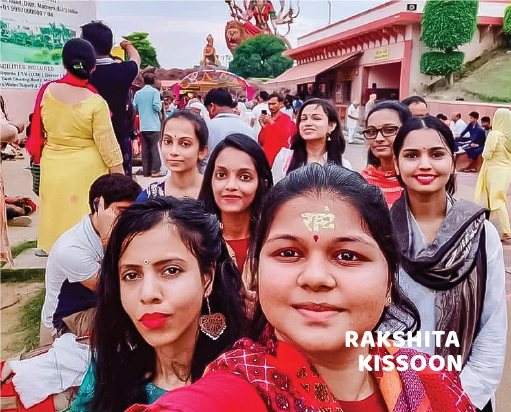
Her favorite festival is Mahasivaratri. She loves the pilgrimage from home to Ganga Talao and back. “My family has been hosting the pilgrims at our residence for the last many years.” She notes “the respect towards each other; people dress well, uniformly and more precisely; and some do service like providing food, first aid, etc. The atmosphere itself during this festival is unique and I truly feel blessed. Participating in four pahar pooja all night while praying without sleep gives another shakti in oneself.”
Her second favorite is Deepavali: “During Deepavali, cleaning and painting the whole house is a common practice which every Hindu household follows. Cooking different types of sweets by watching YouTube videos is another plus. Although gateau banane (a Mauritian sweet dish made up of white flour and banana) is a compulsory dish, nowadays Mauritians are also exploring new dishes from the Internet. Sharing the sweets with neighbors and family, lighting lamps, making rangoli, spending time with family, new dress, gifts are all the things that make this festival my second favorite.
“My daily prayer consists of lighting lamps twice a day at our Hanuman shrines. One thing I hate in our culture is that my family still believes in caste while choosing a partner. I feel no one can decide where they will take birth. One more thing I feel bad about is that more and more families are becoming nuclear families, so we tend to lose the precious rituals that only grandparents can cultivate. Grandparents have better knowledge that the Internet cannot provide.”
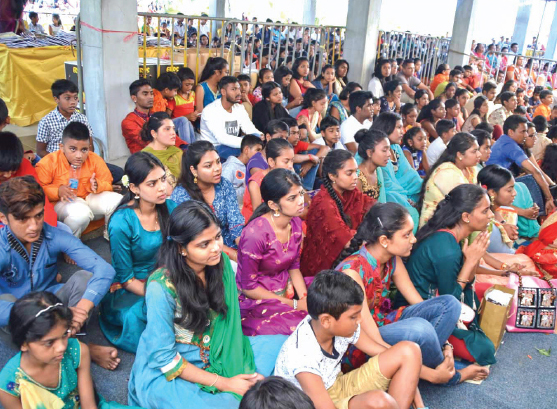
Rajeshwar Seetohul
At 25, theater artist Rajeshwar Seetohul is the youngest theater director on Mauritius. He also runs his own film production company. Rajeshwar became famous by playing the negative character Ravana in the play Raavan-Leela.
Why Ravana?
“Earlier many people were playing Ram-Leela. Everyone was kind of bored watching the same thing again and again. They had already watched it on TV so many times. So to attract youth with a new angle to the same story, we started performing Ravana-Leela. The message is the same, victory of truth over evil, but the story is depicted from
Ravana’s point of view.
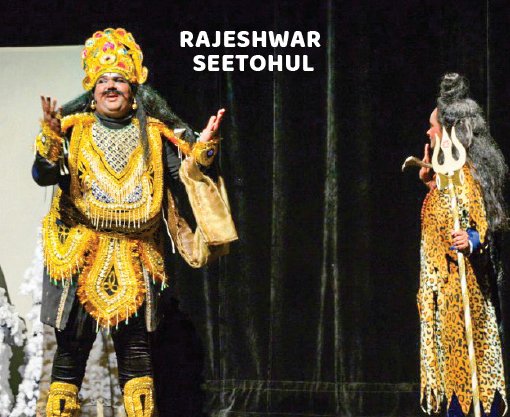
“I am Hindu. I have done my namakarana, annaprasana and chudakarana samskaras. People can tell I am a Hindu as I have my raksha sutra and always wear rudrakshas and an Aum bracelet. I would categorize myself as spiritual but not religious.
“Diwali is my favorite festival, because on this day the whole island is covered with lights and good vibes. All families come together to decorate the house and also for Lakshmi puja. Mauritius is a small island, so it’s easier for everyone to get together, and we look forward to such occasions. Diwali is also the festival that marks victory of good over evil. My second favorite festival is Mahasivaratri, where we get to do service to the pilgrims. I also enjoy Holi.
“Concerning marriage, the issue of caste always comes from elders; but my parents are very open minded and treat everyone the same, so jati won’t be such an issue.
I like the concept of karma in Hinduism. I find some of the rites and rituals senseless, like applying vermillion on a rock and worshiping it without knowing who they are really praying to.”
Rachna
A social worker by profession, Rachna’s “paper name” is Lakshmi Devi Hurday. She is 24 and a trainer at National Leadership Engine. A graduate in pedagogy, she has founded the Indigo Early Learning Center. She is associated with many NGOs.
“Mauritian Hindu youth normally have two names. The paper name is chosen according to horoscope. The other is chosen by the parents, not according to horoscope. Everyone knows us by the second name.”
“When I was growing up, my idea of Hinduism was the daily prayer done by my mother at home. The special Siva Abhishekam that we do each Monday with the whole family holds a special place in my heart. If I don’t participate in the prayer for some reason, I feel something is missing. I have performed the namakarana, annaprasana and vidyarambha samskaras. I occasionally attend Ganesha puja and I wear raksha sutra.”
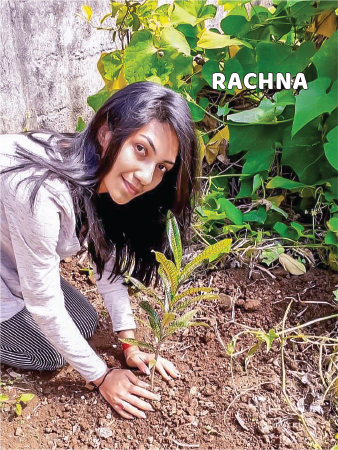
At 16, she stopped regularly going to the temple and participating in prayers because of high school exams. But the regular rituals performed by family and friends have kept her involved with religion and rituals. “Sometimes there is Satyanarayan Katha at a family home. Marriage ceremonies, also, incorporate our customs and traditions. So there are so many things that keep us involved with religion and spirituality on the island.
“One thing that I feel is lacking in Mauritian Hindu society is the gurukulams, which are found in India and other countries but not yet in Mauritius. The caste system is an issue in Mauritius because some create their own groups, but I respect each individual.”
Ishaan Visham

“I come from a very religious family, but sometimes I feel there are many rituals that are no longer recognized by Hindus today. For example, Kul Devi puja which our Mauritian Indian ancestors brought from their homeland. Younger generations do not know the importance of Kul Devi puja which is found in our scriptures. To resolve my own lack of knowledge in certain areas of Hinduism, I went to many masters, swamis, yogis and babas to explore many aspects of our tradition and to understand the science of it. We need to keep our tradition and culture alive for our next generation by accepting our responsibilities and duties to do so. After many years, I decided to start a community digital channel, Tirtha Webcast. Here I try to explain to the viewers key aspects of Hinduism, discussing the importance of rituals and why we do what we do.”
“Today in Mauritius, jati is more a political issue than a societal one. There are some people who think they are from a high caste, but behavior may be low minded. They pressure their children not to think of marrying in a lower caste than theirs and they don’t even understand the concept of Varna in term of the qualities of individual.” Ishaan thinks that some youth don’t understand the real essence of Hinduism. “A few of our young people go on pilgrimage or to temple just to socialize with their friends. These few don’t even care about religion or dharma. Many find a corner for themselves, make bad choices and many become drug addicts in their own worlds.
“Collectively we can bring change to many issues. Hindu organizations, temples and others must give opportunities to the new generation and should entrust them responsibilities for a better future. I believe in the future generation for creating a better world. Those who are blindly doing things should follow a Guru parampara, where a guru can be the guide. A Collective effort, a collective impact, and all of us rising collectively will help in attaining our objectives. In recent years, there is change and our youngsters are more concerned about our religion and culture. The ground work has already been laid and the work must continue to grow and create a bigger impact. Dharmo Rakshati Rakshitah. Thanks and regards. Aum Namah Shivaya!”
Chandanee Senrundon
In Mauritian temples, it’s common to have a bhajan mandali, a singing group. Most of the members of these groups are youth, although kids and elders are also involved. I have always seen Chandanee Senrundon singing Sanskrit stotras at the temple beside my house. Chandanee is a nurse in the government hospital of Mauritius. One Monday, after she sang Narmada Astak Stotra at the Siva Abhishekam puja at the temple, we sat down to chat. I asked why she comes to temple so regularly.
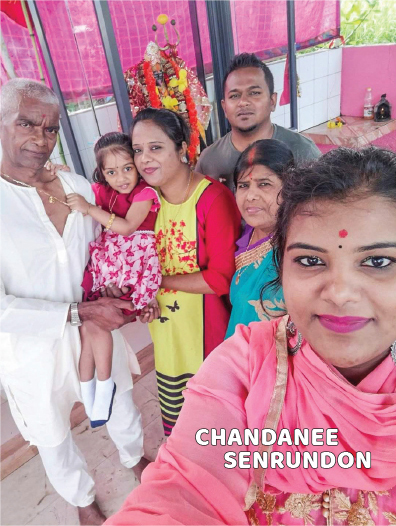
“The temple is my place to recharge. I have to visit regularly for peace of mind. Lighting lamps at our Hanuman shrine twice every day is part of my routine if I am at home. Any Monday when I am on leave, I make sure to visit the temple and participate in Siva abhishekam.” (Every Siva temple on Mauritius performs special Siva Abhishekam puja on Monday evening.) “Along with Siva I also pray to Nandi, Bhairava, Hanuman and Maa Durga.
“Keeping my parents happy is my dharma,” she said. I immediately asked if she would be OK with an arranged marriage. “I don’t know; but I trust my parents, and my parents trust me. So whatever it will be, love or arranged, my parents will be happy with my choice and vice versa.”
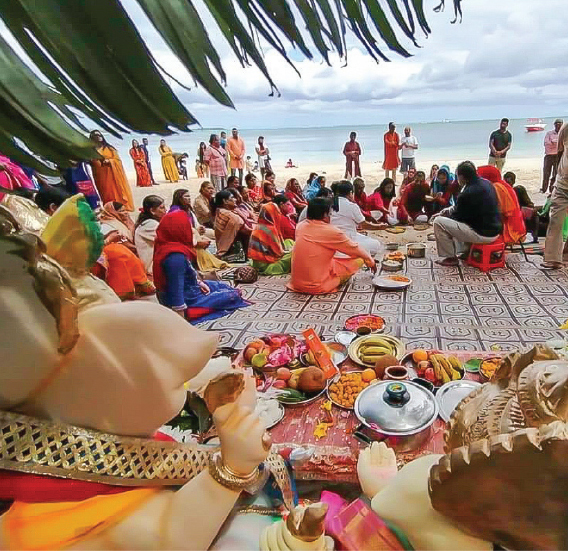
Conclusion
So we saw some youth have found the essence of Hinduism in book knowledge, some in vegetarianism, some in keeping their parents happy, some in serving the soil. Youth are seekers when it comes to religion and spirituality.

The youth of Mauritius are enjoying their dharma. Many festivals here are alive and vibrant because of youth and their unhesitating efforts to make them successful. Mauritian youth don’t just participate, they feel proud of their religion. Their social media, full of religious content, is proof of their pride. During Mahasivaratri, the island’s biggest festival, hundreds of thousands of kawar (decorative frames carrying water pots) reach the holy pilgrimage site at Ganga Talao. And it’s a known fact that 90 percent of kawartis—those who visit Ganga Talao on foot carrying a kawar—are youth under the age of twenty five.
One will hardly find any youth who hasn’t gone to Ganga Talao on foot during Mahasivaratri, taken part in kavadi, or participated in Ganesha Visarjana on our beautiful blue beaches.
Mauritius is a small but multicultural society. There is no indigenous population. All the people were brought as slaves and indentured labor by the French and English colonizers in the seventeenth and eighteenth centuries.
They worked very hard to preserve their religious and cultural identity on this foreign soil. Small things, normally overlooked, were also given much attention, especially in religious matters. In the era before today’s wealth of communication resources, our forebearers kept their dharma alive by putting their lives at risk in this foreign land. Each younger generation was taught to protect dharma and never take religion for granted. Respecting religion and taking pride in it is in the genes of our youth.
Today is a tough time for youth due to pressures from a continuously changing society, so one cannot predict the future; but the present Mauritian youth are a matter of pride for Hinduism.

About the Author

Savita Tiwari grew up in India and is now a resident of Mauritius. She is an avid journalist, blogger, writer and poet with a love of dharma and a penchant for learning more about Hinduism. Contact: savitapost@gmail.com.
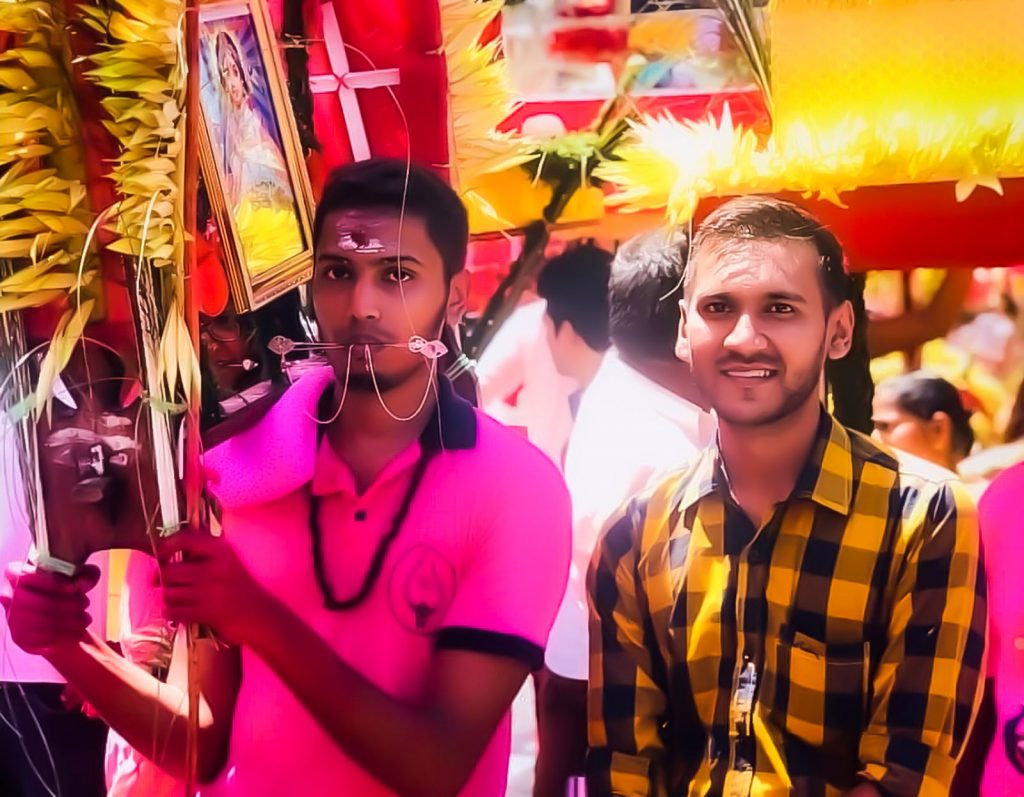
I have just read Savita Tiwari’s informative article “Mauritius Youth Reflect on Hinduism” in the Jan-Feb-Mar edition of HINDUISM TODAY magazine. As a 70-year-old Guyana-born Hindu currently living in Canada, I am delighted to know the Hindu tradition is strong and ever-evolving in Mauritius.
My paternal great grandparents migrated from northern India to Guyana (formerly British Guiana) 141 years ago to work on a sugar plantation as indentured servants. The Indian indenture system in Guyana started in 1838 and ended in 1917.
Savita Tiwari’s article gives me a comprehensive picture of Hinduism in Mauritius.
Thank you Mrs Tiwari and HINDUISM TODAY.
Respectfully yours,
Hemraj Maniram
Hindusm i like, i am Hindu🙏🚩👌